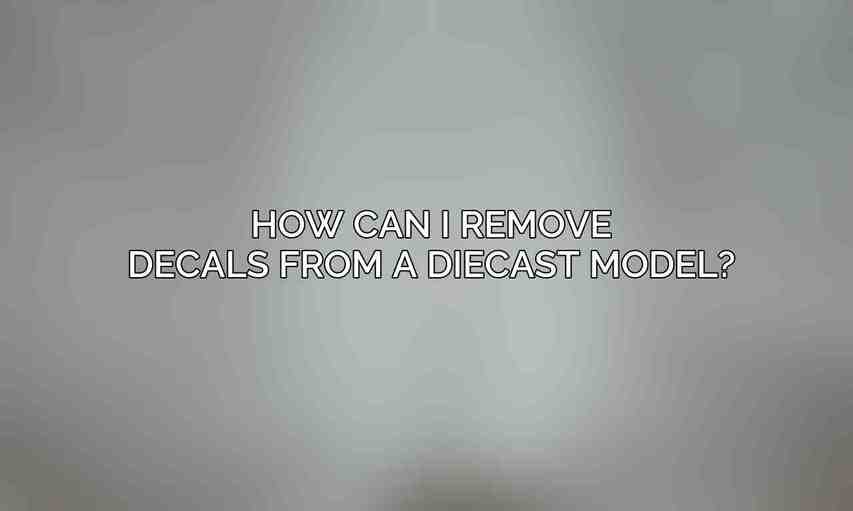Diecast model detailing is the art of enhancing and customizing diecast models to replicate real-life vehicles or add unique features. Detailing involves intricate work to improve the overall appearance and authenticity of the model. It often includes painting, adding decals, and modifying parts to achieve a higher level of realism.
The benefits of detailing diecast models are numerous. It allows enthusiasts to personalize their collections, improve the accuracy of the models, and showcase their creativity and skill. Detailed models are often more visually appealing and can be valuable to collectors. Furthermore, detailing can be a relaxing and rewarding hobby for those passionate about miniature vehicles.
To start detailing diecast models, certain materials and tools are necessary. These can include paints, brushes, sandpaper, primers, clear coats, and precision tools for delicate work. Investing in quality materials is essential for achieving professional-looking results. Additionally, proper safety precautions must be taken when working with chemicals, paints, and tools to ensure the well-being of the hobbyist.
| Feature | Description | ||||||||||||||||||||||||||||||||||||||||||||||||||||||||||||||||||||||||||||||||||||||||||||||||||
|---|---|---|---|---|---|---|---|---|---|---|---|---|---|---|---|---|---|---|---|---|---|---|---|---|---|---|---|---|---|---|---|---|---|---|---|---|---|---|---|---|---|---|---|---|---|---|---|---|---|---|---|---|---|---|---|---|---|---|---|---|---|---|---|---|---|---|---|---|---|---|---|---|---|---|---|---|---|---|---|---|---|---|---|---|---|---|---|---|---|---|---|---|---|---|---|---|---|---|---|
| Material | High-quality diecast metal | ||||||||||||||||||||||||||||||||||||||||||||||||||||||||||||||||||||||||||||||||||||||||||||||||||
| Scale | 1:18, 1:24, 1:43, and 1:64 | ||||||||||||||||||||||||||||||||||||||||||||||||||||||||||||||||||||||||||||||||||||||||||||||||||
| Details | Highly detailed interiors, exteriors, and engines | ||||||||||||||||||||||||||||||||||||||||||||||||||||||||||||||||||||||||||||||||||||||||||||||||||
| Paint | Realistic paint schemes | ||||||||||||||||||||||||||||||||||||||||||||||||||||||||||||||||||||||||||||||||||||||||||||||||||
| Packaging | Protective display cases | ||||||||||||||||||||||||||||||||||||||||||||||||||||||||||||||||||||||||||||||||||||||||||||||||||
| Price | Varies depending on scale and complexity | ||||||||||||||||||||||||||||||||||||||||||||||||||||||||||||||||||||||||||||||||||||||||||||||||||
| Availability | Diecast Model Wholesale | ||||||||||||||||||||||||||||||||||||||||||||||||||||||||||||||||||||||||||||||||||||||||||||||||||
| Visit Diecast | |||||||||||||||||||||||||||||||||||||||||||||||||||||||||||||||||||||||||||||||||||||||||||||||||||
Surface Preparation Techniques
A. Cleaning and Degreasing the Model

Before beginning any detailing work, it is crucial to clean and degrease the model to remove any dirt, dust, or oils that may affect the finish. Using alcohol, Q-tips, and a soft cloth, wipe down the model to ensure a clean surface for painting and detailing.
B. Sanding and Polishing
Sanding and polishing are essential steps to smooth out imperfections and create a flawless base for painting. Utilizing sandpaper of various grits, a polishing compound, and a polishing wheel, carefully refine the surfaces of the model to prepare it for the next stages of detailing. The goal is to achieve a smooth and even texture for optimal paint adhesion.
For more interesting diecast models and accessories, you can visit Diecast Models Wholesale.
Frequently Asked Questions
What tools are essential for diecast model detailing?
Some essential tools for diecast model detailing include fine-point brushes, paints, primers, sandpaper, and a magnifying glass.
How can I remove decals from a diecast model?

Decals can be removed by soaking the model in warm, soapy water and gently scraping them off with a hobby knife or tweezers.
What are some advanced techniques for enhancing model detailing?
Advanced techniques for enhancing model detailing include using dry brushing to create depth and weathering effects, as well as airbrushing for smooth finishes.
How can I protect the paint job on my diecast model?
To protect the paint job on your diecast model, consider applying a clear coat or varnish after painting and detailing to seal and protect the finish.
Are there any specific safety precautions to keep in mind when detailing diecast models?

When detailing diecast models, it’s important to work in a well-ventilated area, wear a mask when using aerosol products, and handle sharp tools with care to avoid injury.

